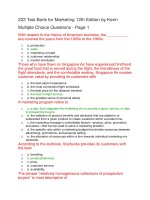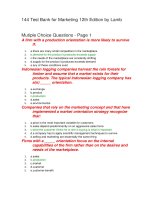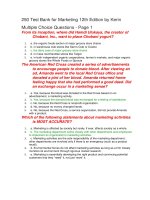Law for business 12th edition by barnes dworkin richards solution manual
Bạn đang xem bản rút gọn của tài liệu. Xem và tải ngay bản đầy đủ của tài liệu tại đây (435.69 KB, 9 trang )
Law for Business 12th edition by A. James Barnes, Terry Morehead Dworkin,
Eric L. Richards Solution Manual
Link full download test bank: />Link full download solution manual: />
CHAPTER 2: DISPUTE SETTLEMENT
LECTURE OUTLINE
1.
The introductory Plastix hypothetical raises the two main themes of the chapter:
(1) how to resolve disputes outside of a traditional lawsuit, and, (2) how a lawsuit
would proceed, including basic jurisdictional and procedural concepts, when a
lawsuit is brought.
a.
The hypo can be used to point out the advantages of resolving a
dispute through direct discussion and compromise. These advantages
include maintaining good relations (especially with long-time
customers) and avoiding expense (especially in a dispute involving a
relatively small amount like $2,000).
b.
The first Plastix question invites a discussion of the various means of
dispute settlement that do not involve a lawsuit. Since lawsuits get the
attention of the media, it is easy for students to overlook what may be
preferable alternatives. Compare the advantages and disadvantages of
each alternative.
(1) Point out that arbitration and mediation are the forms of ADR most
commonly used by businesspeople. Discuss the differences between
mediation and arbitration, and what qualities make one more
appropriate for certain types of disputes than the other. Point out that
contracts between consumers and businesses increasingly require
that disputes be arbitrated. An example from an insurance or
securities contract could be used.
(2) Employment contracts also increasingly require arbitration. Some
courts and legislators view such contracts as contracts of adhesion and
disallow them. Ask the students if they feel they have a choice in
agreeing to such a term if they want the job.
(3) Note that there is now a combined Med/arb ADR mechanism.
(4) Discuss international arbitration and the international treaties that
facilitate it. Most often international contracts require arbitration. Be
certain that students understand the great deference that courts give
arbitration – particularly in the international environment. Note the
existence of the UN Convention on the Recognition and Enforcement
of Foreign Arbitral Awards and its effect on enforcement. Compare it
to the WTO rules. Point out that regional trade organizations, such as
NAFTA, also have ADR mechanisms.
Law for Business, 12e
Copyright © 2015 McGraw-Hill Education. All rights reserved. No reproduction or distribution without the prior written consent of McGraw-Hill Education.
2-1
Barnes/Dworkin/Richards, Law for Business, 12e, Instructor’s Manual, Chapter 2
(5) Discuss the differences between a minitrial and a summary jury trial.
Point out that a minitrial is a nonbinding settlement procedure. The
Center for Public Resources Legal Program has developed model
minitrial procedures. They recommend that the model minitrial
agreement be incorporated into major contracts between companies,
especially where there are terms that may give rise to serious dispute.
That agreement should prohibit either party from initiating litigation
before the minitrial is concluded. Note that the use of a summary jury
trial is generally directed by the court.
2-2
(6)
Contrast private judging with the other forms of ADR.
(7)
You may want to note that settlement negotiations are now taking
place on the Web. Services such as Cybersettle, clickNsettle, and
U.S. Settlement Corp., offer rounds of bidding to settle cases. For
example, lawyers can negotiate for three rounds, and when they
arrive at an agreed-upon range (usually 30% or $5,000) the case
automatically settles for the medium amount.
c.
Discuss the disadvantages of using ADR mechanisms. Note that increased
reliance on some forms of ADR could lead to a two-tier justice system,
one for the rich, and the public system for the poor. ADR places many
disputes outside the evolutionary common law system and avoids open
proceedings, written decisions, and appellate review. Also, when cases go
through ADR, there is no public reporting of them, or oversight, and
knowledge of important issues such as discrimination or safety may be
lost. For example, Ford and Firestone arbitrated more than fifty cases
involving deadly tire-tread separation. Only after years of possibly
preventable deaths and injuries were journalists and consumer advocates
able to piece together information of individual lawsuits. Also, discuss
why businesses would file suit instead of using ADR. Point out that
sometimes a lawsuit is filed in order to get stalled negotiations moving
again. However, this is risky because it can make it impossible to continue
the business relationship.
d.
The material at the end of the chapter dealing with court problems
and solutions could be dealt with here. Certainly the problems of delay
and expense are illustrative of why more people are turning to
alternatives. It was put at the end of the chapter because it was felt that the
material would be more meaningful after the students had a better
understanding of how the courts work. Discussion points could include:
(1)
Why we are such a litigious society.
(2)
The backlogs in our courts, including the impact of drug trials on
delays of civil suits. It can take up to four years for a civil suit to
get a trial date in some states. The underfunding of the system and
Instructor’s Resource Manual
Copyright © 2015 McGraw-Hill Education. All rights reserved. No reproduction or distribution without the prior written consent of McGraw-Hill Education.
Barnes/Dworkin/Richards, Law for Business, 12e, Instructor’s Manual, Chapter 2
politics delaying judicial appointments are also problems.
(3)
Whether the large number of lawyers contributes to the problem.
2.
Discuss the kinds of issues that courts will not hear such as moot or hypothetical
cases. Also point out that there are certain kinds of disputes that courts generally
will not hear, such as “educational malpractice” cases, or cases involving political
questions. You might want to discuss the Supreme Court’s decision to hear the
Florida presidential voting case in this context. Discuss the reasoning behind
such refusals. The students should understand that the courts do not provide a
remedy for every wrong.
3.
The second question in the Plastix hypo raises issues of jurisdiction. In your
discussion of jurisdiction, emphasize that the idea relates to which governmental
entity has the power to issue binding legal decisions affecting people, property
and activities. Discuss personal jurisdiction.
a.
You may want to explain venue, and differentiate it from jurisdiction.
b.
You may want to point out that the Internet and the transnational flows of
people and products have raised new issues for jurisdiction. The Attaway
case illustrates the issue of personal jurisdiction over on-line activities.
Attaway v. Omega, pg. 32
The sale of a car by an Indiana resident to a buyer on eBay and paid for through PayPal
raised jurisdictional issues when problems with the transaction arose. The court holds
that it does have jurisdiction over the Idaho buyers.
Points for Discussion: This is a good case to outline or have the students do so because
of the many parties and steps involved. It is increasingly clear that modern businesses no
longer require an actual physical presence in a state in order to engage in commercial
activity there. With the advent of “e-commerce,” business may set up shop without ever
actually setting foot in the state where they intend to sell their wares. Use of PayPal
further complicated the jurisdictional issue here. Note how many avenues of relief and
resolution were involved here.
Our conceptions of jurisdiction must be flexible enough to respond to the realities of
the modern marketplace. Businesses who structure their activities to take full advantage
of the opportunities that virtual commerce offers can reasonably anticipate that these
same activities will potentially subject them to suit in the locales that they have targeted.
Might this cause some businesses to avoid on-line transactions with “high risk”
jurisdictions? According to a global survey on internet jurisdiction, it appeared that some
companies seemed to avoid business with such jurisdictions and employed various legal
and technological tools to influence jurisdictional outcomes. The survey suggested that
North American companies are generally more worried about expansive Internet-related
jurisdiction exposure than were their counterparts in Europe and Asia. Discuss the ways
Law for Business, 12e
Copyright © 2015 McGraw-Hill Education. All rights reserved. No reproduction or distribution without the prior written consent of McGraw-Hill Education.
2-3
Barnes/Dworkin/Richards, Law for Business, 12e, Instructor’s Manual, Chapter 2
that expansive notions of jurisdiction shape the way organizations transact business, both
in the States and abroad. In a global business context, as internet jurisdiction “grows,” so
too does the need for companies to familiarize themselves with the laws of the countries
in which they do transactions.
4.
For your discussion of the state courts, you may wish to prepare a diagram of the
state court system in your state if it differs significantly in terminology or
structure from the California system presented in the text.
a.
5.
(1).
An assignment the students are likely to find interesting and fun is
to watch one of the televised judge shows such as People’s Court,
brief one of the situations (for practice when cases are read) and
describe how the court differs in procedure and jurisdiction from a
trial court. Tell them to assume that People’s Court is the same as
a small claims court.
(2).
Note that small claims court can be seen as a form of ADR, and
shares many of its advantages.
(3).
Plastix, if it decided to sue, would be advised to seek recovery of
its $2,000 in small claims court. This would be a good time to
discuss how expensive it is to litigate, if this has not already been
done.
b.
Stress that trial courts determine the facts as well as render a
decision, while appellate courts only decide questions of law.
c.
Stress that an appeal is not a “second trial” as the students usually think
of it, and that the overwhelming majority of appeals are not successful.
Appellate procedure is discussed later in the chapter.
Point out that the basic structure of the federal courts is similar to that of the state
courts except there are no courts like small claims courts.
a.
2-4
Students should be made familiar with how cases are brought in the small
claims court, if any, in their city. Note that a small claims court was used
in the Attaway case.
Discuss diversity jurisdiction, and how it arose. Point out that the reasons
for its creation no longer exist, and that there is a strong movement for its
elimination, primarily because of the burden it puts on the federal court
system, and the forum shopping that it engenders.
(1).
Note that the jurisdictional amount is $75,000.
(2).
Point out the fact that federal courts typically apply state law in
Instructor’s Resource Manual
Copyright © 2015 McGraw-Hill Education. All rights reserved. No reproduction or distribution without the prior written consent of McGraw-Hill Education.
Barnes/Dworkin/Richards, Law for Business, 12e, Instructor’s Manual, Chapter 2
diversity cases.
b.
(3).
Point out that for diversity jurisdiction purposes, a corporation is
deemed to be a citizen of both the state where it has been
incorporated and the state where it has its principal place of
business.
(4).
Example: Problem Case number 7.
In your discussion of the Supreme Court you may want to bring up the
controversy about whether the Court is too activist, and makes law in
areas that should be left to the legislature. The abortion decisions are an
excellent focus for the discussion. The recent abortion decisions are also a
good focus for a discussion of the impact of different personnel on the
outcome of cases, Reagan’s and Bush’s influence on the Court, and
whether the current Court is being equally “activist” in changing
precedent.
(1).
In your discussion of certiorari, point out that this is the way
almost all cases come to the Supreme Court. Congress eliminated
the right of appeal in 1988. Note that the Supreme Court hears
very few cases appealed to it. Stress that a denial of cert. is not a
decision on the merits, and should not be interpreted as such. Also
stress that most cases cannot be appealed from state courts to the
Supreme Court.
(2).
Explain concurring and dissenting opinions, and point out that they
can occur in any court opinion, not just in Supreme Court opinions.
6.
Explain the adversary system, and discuss its pros and cons. Note that it is at
work in each stage of a lawsuit.
7.
There are two primary reasons why basic procedure should be learned. One is so
that if students or their employers become involved in a lawsuit, an understanding
of procedure will make them better clients and permit their lawyer to do a better
job of representing their interests, as well as enabling them to understand what is
going on. Second, it will facilitate understanding the cases in subsequent
chapters. The third question in the Plastix case raises procedural questions.
a.
Stress that the basic purpose of procedure is fairness.
b.
Discuss class actions, and point out that even outside of class actions,
lawsuits often involve more than one party on each side.
Law for Business, 12e
Copyright © 2015 McGraw-Hill Education. All rights reserved. No reproduction or distribution without the prior written consent of McGraw-Hill Education.
2-5
Barnes/Dworkin/Richards, Law for Business, 12e, Instructor’s Manual, Chapter 2
(1)
Discuss the Class Action Fairness Act and the reasons it
was enacted.
Wal-Mart Stores, Inc. v. Dukes pg. 38
A class made up of 1.5 million Wal-Mart employees was denied the right to bring a
class action suit for sex discrimination.
Points for Discussion: Explain why there must be a “commonality” among the plaintiffs.
Have the students explain why the Court found it lacking. Do they think the size of the
class was a cause of finding no commonality? Ask them what recourse most of those in
the class have if they can’t sue as a class. Can most individually afford a lawyer? Point
out that the EEOC could bring a suit on their behalf. Should the lack of a general policy
of discrimination preclude a suit for discrimination? Is this decision likely to further the
policy of nondiscrimination?
Additional Example: Problem Case number 6. Point out that Wong would not now be
able to bring the suit due to the Supreme Court case. Explain that without a class action,
the damages are too small to be worth suing about. However, state attorney generals
could sue.
c.
2-6
Discuss the various steps and documents that make up the pleadings. The
students may be interested to know that the pleadings appearing in the
book come from an actual case, although fact changes have been made.
(1).
In your discussion of summons, you may want to discuss the
problem of permitting service of a summons by delivery to a place
of business or residence rather than service on the person. One
result is the phenomenon known as “sewer service. “ Process
servers have been known to attest to the fact they have delivered a
batch of summons to the specified addresses when they have only
burned them or tossed them into the sewer. The defendant, often
poor and unfamiliar with his or her rights, then is saddled with a
default judgment. Service by mail is more reliable because the
officer in charge can more closely supervise a mailing than
personal delivery. Point out that if a summons is not answered, a
default judgment can be entered.
(2).
Make sure students can distinguish between legal facts and
evidence. (Evidence is the testimony of witnesses and exhibits,
such as the signed contract in a breach of contract suit, presented at
the trial. The legal facts are the basic facts necessary to be proved
by the evidence in order for the plaintiff to win the case. For
example, in a breach of contract suit the legal facts required would
include the making of a contract, the failure of the defendant to
Instructor’s Resource Manual
Copyright © 2015 McGraw-Hill Education. All rights reserved. No reproduction or distribution without the prior written consent of McGraw-Hill Education.
Barnes/Dworkin/Richards, Law for Business, 12e, Instructor’s Manual, Chapter 2
perform an obligation under it, and economic injury to the plaintiff
resulting from the breach.) Why is numbering of separate
paragraphs for each legal fact required? (For clarity and so that
after the answer is filed all concerned can determine which legal
facts are being contested and which are not; also whether all
necessary facts have been alleged by the plaintiff.)
(3).
Discuss an affirmative defense. Ask the students to determine
whether World Press or Herbert Miller stated an affirmative
defense in their answer.
(4).
The defendant can move to dismiss the case for failure to state a
cause of action for which a remedy can be granted. In the past this
was called a demurrer. In most states today it is merely called a
motion to dismiss. After such a motion has been filed the attorneys
for the two parties then give the judge arguments as to why the
motion should be sustained or overruled. If sustained the case ends,
unless the judge permits the plaintiff to amend the complaint. If the
motion is overruled the defendant must answer.
(a).
Explain that at any point in the trial process that it becomes
clear that one party should win, the process is stopped.
d. You may want to elaborate on the various kinds of discovery, especially
a deposition. Also you could talk about e-discovery.
e. Discuss the pre-trial conference, and the inducement this is to settlement.
Point out that over 90 per cent of cases filed are settled or disposed of in
some other way before they get to trial.
e.
When discussing the trial, you may want to discuss jury selection, or
voir dire. Stress the different roles of the judge and jury at the trial—e.g.,
law versus facts.
(1).
Explain burden of proof, and preponderance of the evidence.
(2).
Explain the role of objections at trial and their necessity for
appeals.
(3).
You may want to discuss general and special verdicts, and
directed verdicts at this point.
(4).
Point out that judgment n.o.v. is a jury policing device designed to
take the case away from the jury in certain situations. This could
lead to a general discussion of the wisdom and necessity of having
juries today.
Law for Business, 12e
Copyright © 2015 McGraw-Hill Education. All rights reserved. No reproduction or distribution without the prior written consent of McGraw-Hill Education.
2-7
Barnes/Dworkin/Richards, Law for Business, 12e, Instructor’s Manual, Chapter 2
10.
Stress that a judgment is “just a piece of paper” and does not mean that payment
automatically follows for the plaintiff. Collection can be time consuming and
expensive. Discuss the various ways a judgment can be enforced.
11.
Contrast appellate procedure with trial procedure. Point out that an appeal is
essentially a written process that is designed to ensure that the parties got their
“fair day in court.” Make sure the students understand what a material error is.
a.
12.
An overruling of the finding of facts in the trial court is possible if the
appellate court finds that there was no competent evidence on which an
unbiased and rational fact finder could base the finding. However, such a
determination by an appellate court is rare and students should realize this.
Discuss the problems with the courts, and the pros and cons of various solutions,
if this was not done earlier.
ANSWERS TO QUESTIONS AND PROBLEM CASES pg. 48
1. One difference is that a trial has a jury (or sometimes a judge) determine the truth
from the evidence presented but new evidence is not introduced on appeal. There
is not a trial at the appellate level; the appeal is mainly conducted by writings
such as briefs and trial transcripts. Attorneys generally conduct the trial but can
only appear on appeal if allowed by the judges and if allowed, they have a very
limited role.
2. Depositions are examinations under oath in the presence of the attorney from the
other party. Interrogatories are written questions which are answered in writing
under oath.
2-8
3.
The judge’s role in the adversary system is essentially one of a referee, making sure
the lawyers follow the rules of procedure and fairness is maintained. The judge also
instructs the jury on the law, and rules on evidentiary questions raised at trial. In a
code system, the judge plays a much more active role in directing proceedings in
court, requesting certain evidence, and questioning witnesses.
4.
In mediation, the parties to a dispute choose a third party to help them settle it.
The mediator usually proposes bases for settlement, but does not determine
the outcome. Arbitration differs from mediation in that the person to whom the
dispute is submitted decides the outcome.
5.
The burden of proof in a civil case is preponderance of the evidence. The jury
determines whether the plaintiff has met that burden.
6.
Arbitration agreements can take a back seat to public policy in some cases if the
agreement waives plaintiff’s substantive rights or remedies. The federal statute
Instructor’s Resource Manual
Copyright © 2015 McGraw-Hill Education. All rights reserved. No reproduction or distribution without the prior written consent of McGraw-Hill Education.
Barnes/Dworkin/Richards, Law for Business, 12e, Instructor’s Manual, Chapter 2
does not encompass plaintiff’s claim, which is essentially a billing dispute and
should be decided under state law. If the class action waiver were enforced,
consumers would effectively not be able to vindicate their rights because their
damages are too small to make arbitration worthwhile. Wong v. T-Mobile USA,
Inc., 2006 U.S. Dist. LEXIS 49444 (E. Dist. Mich. July 20, 2006).
7.
The suit can be brought in federal court under diversity jurisdiction because
plaintiff and defendant are from different states, and Connie is suing for more
than $75,000 in damages. She could also bring the suit in California. If she did,
the restaurant could ask that the case be removed to federal court.
Law for Business, 12e
Copyright © 2015 McGraw-Hill Education. All rights reserved. No reproduction or distribution without the prior written consent of McGraw-Hill Education.
2-9









